9 real places on the world that seems scientifically impossible
It may be nature or man made
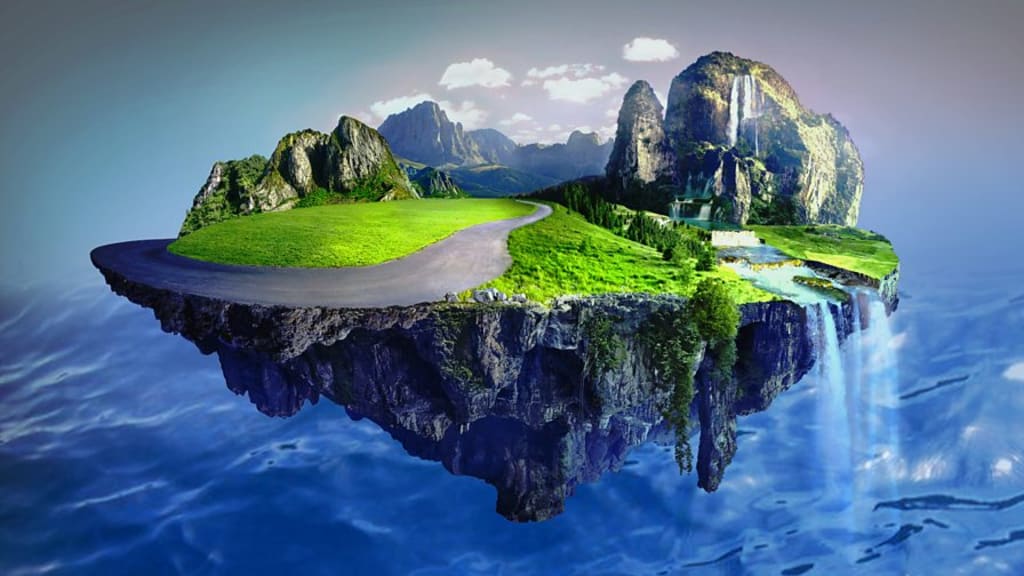
There are is a certain enjoyment in being completely confused its a reason some of us travel to be baffled to be surprised to be shocked to look around our foreign surroundings and have absolutely no idea what's going on this weirdness that you notice while on the roads come in different guises it can be quirks of culture or it can be unique attraction, it can be natural or it can be man-made in some cases it can be complete mystery to even those who claim it as their own. these places are really weird and they're definitely worth seeing for yourself
1., Mount Roraima:
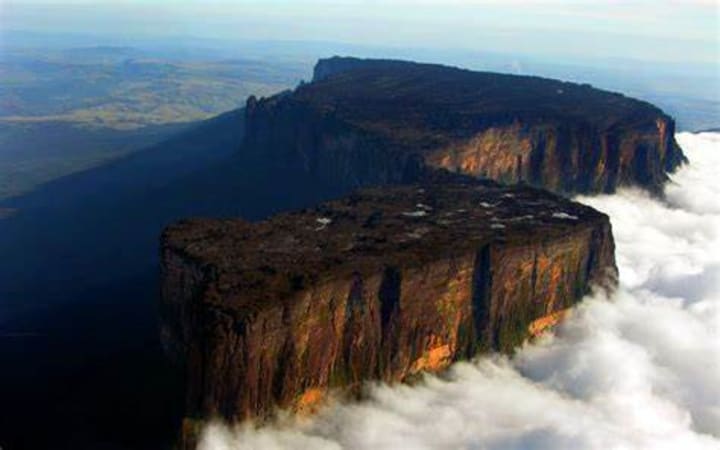
Mount Roraima, also known as Roraima Tepui or Cerro Roraima, is a stunning tabletop mountain situated in South America. It is located at the tri-point border of Venezuela, Brazil, and Guyana, and is a part of the larger Pakaraima Mountain chain.
Mount Roraima is a unique natural wonder, known for its flat summit that extends over an area of approximately 31 square kilometers. The mountain's summit stands at an elevation of 2,810 meters (9,219 feet) above sea level, making it one of the highest peaks in the region.
Mount Roraima is characterized by its steep vertical walls and unique rock formations, such as spires, pinnacles, and cliffs, which are the result of centuries of erosion. The mountain is also home to a variety of rare plant and animal species, including the Roraima Bush Toad, Roraima Mouse Opossum, and the endemic Roraima black frog.
The mountain has been a subject of interest for explorers and adventurers for centuries. In 1595, Sir Walter Raleigh made the first recorded attempt to climb the mountain, but he was unsuccessful. The first successful ascent of Mount Roraima was made in 1884 by British explorer Everard Im Thurn, along with two local guides.
Today, Mount Roraima is a popular destination for tourists and adventurers. Visitors can explore the mountain's stunning landscape and unique flora and fauna on guided tours, which usually take several days. The climb to the summit is challenging and requires a certain level of fitness and experience, but it is an unforgettable experience that rewards visitors with breathtaking views of the surrounding landscape.
In addition to its natural beauty, Mount Roraima also holds cultural and spiritual significance for the indigenous people of the region. The mountain is considered a sacred site by the Pemon and Kapon peoples, who have inhabited the area for centuries. According to their beliefs, Mount Roraima is the birthplace of all life on Earth and a gateway to the spirit world.
Overall, Mount Roraima is a unique and awe-inspiring natural wonder, with a rich history and cultural significance. It is a must-visit destination for anyone who loves nature, adventure, and exploring new cultures.
2., Ram setu:
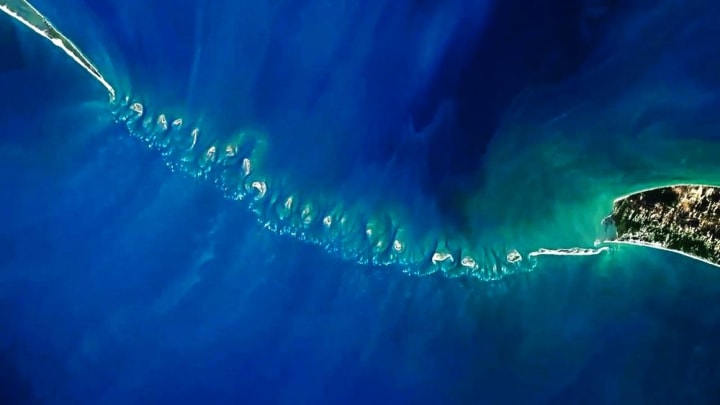
Ram Setu, also known as Adam's Bridge, is a long chain of limestone shoals that runs between the southeastern coast of India and the northwestern coast of Sri Lanka. According to Hindu mythology, it was built by Lord Rama and his army of monkeys and bears to cross over to Lanka to rescue his wife Sita from the demon king Ravana.
The bridge is believed to have been constructed over 1.7 million years ago, and there has been a long-standing debate about its origin and purpose. While some scientists argue that the bridge is a natural formation, others believe that it was man-made.
The mystery surrounding Ram Setu is based on the different theories that have been proposed over the years. One theory suggests that the bridge was constructed using advanced engineering techniques, such as levitation, by an ancient civilization that had access to sophisticated technology. Some believe that this civilization may have been the legendary city of Atlantis, while others speculate that it was an advanced civilization that existed in India.
Another theory suggests that the bridge was constructed by extraterrestrial beings, who visited Earth and helped ancient humans to build structures like the pyramids of Egypt and Machu Picchu in Peru.
Despite the ongoing debate, there is evidence that supports the man-made origin of Ram Setu. The bridge is composed of limestone rocks that are not found in the area where it is located, and its structure and alignment are consistent with ancient engineering practices. Additionally, there are references to the bridge in ancient Hindu texts, which describe it as a man-made structure.
The mystery of Ram Setu continues to intrigue scientists, historians, and scholars around the world. While some believe that it is a natural formation, others argue that it was built by an advanced civilization or extraterrestrial beings. Regardless of its origin, Ram Setu remains a remarkable engineering feat and an important cultural landmark in Hindu mythology.
3., Moving mountain:

The Moving Mountain, also known as the Mountain that walks, is a legendary story that has been passed down for centuries. It is said to have originated in China during the Han Dynasty, which lasted from 206 BCE to 220 CE.
According to the legend, there was a mountain that moved and changed its location every year. The locals believed that the mountain was alive and had the power to protect them from harm. They also believed that the mountain was a sacred site, where spirits and gods dwelled.
Over time, the Moving Mountain became a popular pilgrimage site, and people from all over China traveled to see it. However, despite their best efforts, no one was able to determine the cause of the mountain's movement.
The mystery of the Moving Mountain continued for many years until a group of scholars decided to investigate. They traveled to the site and conducted a thorough examination of the area, looking for any signs of movement.
After many months of study, the scholars discovered that the Moving Mountain was not a natural phenomenon but was, in fact, a massive stone slab that was being moved by a group of people. They found a system of levers and pulleys that were being used to move the stone slab, which weighed several thousand tons.
The scholars were surprised by their discovery and wondered why anyone would go to such lengths to move a stone slab. After further investigation, they uncovered a hidden chamber beneath the stone slab, which contained ancient texts and artifacts.
The texts revealed that the Moving Mountain was created by a group of monks who were seeking to hide the chamber and its contents from invaders. They believed that by moving the stone slab every year, they could keep the chamber and its contents hidden from those who would seek to steal or destroy them.
The Moving Mountain mystery was finally solved, and the scholars were able to uncover an important piece of Chinese history. The story of the Moving Mountain has since become a legend and is often used as a metaphor for the power of determination and the importance of protecting one's cultural heritage.
4., Magnetic hill:
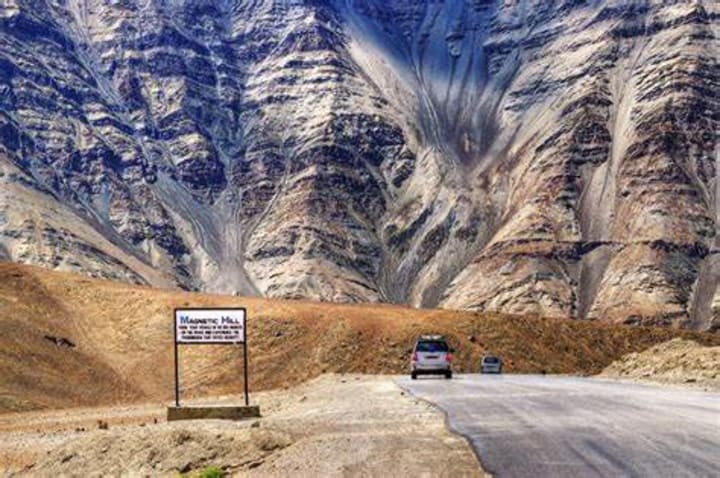
Magnetic Hill is a mysterious and fascinating site located in Ladakh, India. The hill is famous for its unique magnetic properties that seem to defy the laws of gravity and physics.
According to local legends, the Magnetic Hill was once a route used by ancient trade caravans. The magnetic forces of the hill were said to have been harnessed by the traders to help them move their heavily loaded carts up the steep incline without the use of animals or machines.
Over time, the Magnetic Hill became a popular site for travelers and tourists, who would come to witness the incredible phenomenon of their cars rolling uphill without any external force. The hill became a popular destination for curious visitors from all over the world, and many theories were put forth to explain the strange occurrence.
One of the most popular theories is that the Magnetic Hill is an optical illusion created by the surrounding landscape. The hill appears to be sloping upwards, but in reality, it is sloping downwards. This creates an illusion that makes cars and other vehicles appear to roll uphill.
However, this theory does not explain why the hill has such strong magnetic properties. Another theory suggests that the hill is located on a geological fault line, which creates a powerful magnetic field. This theory has some scientific basis, as Ladakh is known to be a region with a high concentration of mineral deposits.
Despite the many theories, the mystery of the Magnetic Hill remains unsolved. The strange and unexplained phenomenon continues to attract visitors from all over the world, and the site remains a popular tourist destination in India.
Some believe that the Magnetic Hill is a site of spiritual significance, and that the powerful magnetic forces are the result of divine intervention. Others believe that it is simply a natural phenomenon that has yet to be fully understood.
Whatever the explanation may be, the Magnetic Hill remains a testament to the mysteries of the universe and the power of human curiosity to seek out answers.
5., Sea splits into two:
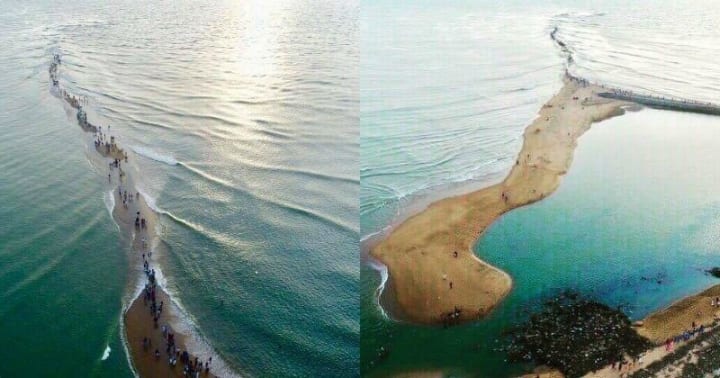
The story of the Sea splitting into two is a well-known biblical event that took place during the time of Moses. According to the book of Exodus, God performed a miracle by splitting the Red Sea, allowing the Israelites to cross over to the other side on dry land.
The story goes that the Israelites had been enslaved in Egypt for over 400 years and were seeking their freedom. Moses, who had been chosen by God to lead the Israelites, led them out of Egypt and towards the Promised Land. However, they soon found themselves trapped between the Red Sea and the pursuing Egyptian army.
In a moment of desperation, Moses prayed to God, who then instructed him to stretch out his hand over the sea. As Moses did so, the sea miraculously split into two, creating a pathway for the Israelites to cross over to the other side.
The story of the Sea splitting into two has been passed down for thousands of years and is considered to be one of the most significant miracles in the history of the Israelites. However, there have been many attempts to explain the event through scientific means.
One theory suggests that a strong wind caused the water to recede, creating a pathway for the Israelites to cross over. Another theory suggests that the Israelites crossed over a shallow part of the Red Sea that had been exposed by a natural phenomenon known as a "wind setdown."
Despite these attempts to explain the event through natural means, the story of the Sea splitting into two remains a mystery that has yet to be fully understood. It continues to be a powerful symbol of faith and divine intervention, inspiring people all over the world to trust in the power of a higher power.
6., Kalimutu Indonesia:
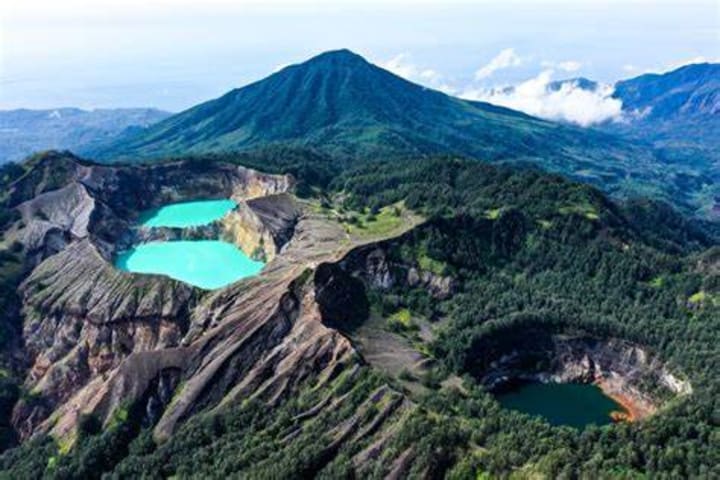
The Kelimutu volcano is located on the Indonesian island of Flores and is famous for its three crater lakes, each with a different color. The lakes are a popular tourist destination, drawing visitors from all over the world.
According to local folklore, the three lakes were once the sacred resting places of the spirits of the dead. The lakes were believed to be portals to the afterlife, and the colors of the lakes were thought to represent the moods of the spirits.
The largest lake, Tiwu Ata Mbupu, is a deep green color, which was believed to be the resting place of the spirits of the old people. The second lake, Tiwu Nuwa Muri Koo Fai, is a deep blue color and was believed to be the resting place of the spirits of young people. The third lake, Tiwu Ata Polo, is a bright red color and was believed to be the resting place of the spirits of evil people.
The origin of the different colors of the lakes is still a mystery. Some scientists believe that the colors are the result of the volcanic activity in the area, while others believe that they are the result of the minerals and microorganisms present in the water.
The first recorded scientific exploration of Kelimutu was by Dutch colonial officer Van Suchtelen in 1915. He was the first to record the colors of the lakes and their variations over time. Since then, many scientists have studied the volcano and the lakes, but the mystery of their colors remains unsolved.
Kelimutu is also known for its unpredictable volcanic activity. The volcano erupted in 1968, causing widespread damage and loss of life. The most recent eruption occurred in 2016, reminding visitors of the potential danger of the area.
Despite the mystery and danger surrounding Kelimutu, it remains a popular destination for tourists and researchers alike. The volcano and its lakes continue to inspire awe and wonder in those who visit, reminding us of the power and beauty of nature.
7., Floating Island:
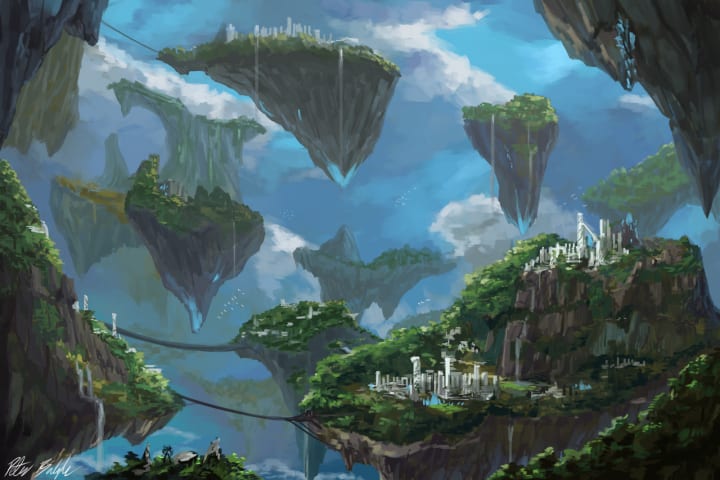
The Floating Island of Lake Titicaca
Lake Titicaca, located in the Andes Mountains between Peru and Bolivia, has long been shrouded in mystery and myth. According to ancient Incan legend, the god Viracocha emerged from the waters of the lake to create the sun, moon, and stars. But perhaps the most intriguing mystery of Lake Titicaca is the Floating Island.
The Floating Island is a man-made structure constructed entirely of totora reeds, a plant that grows abundantly in the lake. The island, which measures approximately 70 by 100 meters, is home to the Uros people, who have lived on Lake Titicaca for centuries. The Uros are known for their unique way of life, living on reed islands and using reed boats for transportation.
According to Uros legend, the Floating Island was created by their ancestors in order to escape the violence and warfare of the mainland. The Uros people have long been a target of invasion, and they built the island as a way to protect themselves. The totora reeds not only provide a sturdy foundation for the island, but they are also edible and can be used to make tools, baskets, and clothing.
While the Floating Island has been a part of Uros culture for centuries, it was largely unknown to the outside world until the Spanish conquest of Peru in the 16th century. Since then, the island has become a popular tourist destination, with visitors coming from all over the world to see the unique structure and learn about Uros culture.
Despite its popularity, the Floating Island remains shrouded in mystery. Some researchers believe that the island was built much more recently than the Uros claim, and that it was constructed as a way to attract tourists and generate income. Others believe that the island may have been built by a pre-Incan civilization, and that the Uros simply inherited it.
Regardless of its origins, the Floating Island remains a fascinating and enigmatic structure. The Uros people continue to live on the island and maintain their traditional way of life, using the totora reeds to build homes, boats, and other structures. As the world continues to change around them, the Floating Island remains a testament to the ingenuity and resilience of the Uros people, and a symbol of the enduring mystery and beauty of Lake Titicaca.
8., Superstition mountain:
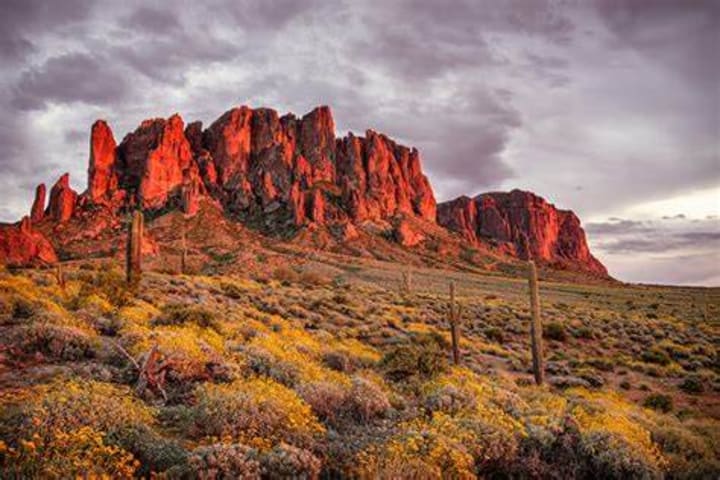
Superstition Mountain: The Lost Dutchman's Mine
Superstition Mountain, located in Arizona, has long been the subject of mystery and legend. The mountain is named for the many superstitions associated with the area, including tales of ghosts, mysterious lights, and hidden treasures. But perhaps the most enduring mystery of Superstition Mountain is the legend of the Lost Dutchman's Mine.
The Lost Dutchman's Mine is said to be a secret gold mine hidden somewhere in the Superstition Mountains. The legend dates back to the mid-19th century, when a German immigrant named Jacob Waltz claimed to have discovered a rich vein of gold in the mountains. Waltz, who became known as the "Dutchman," reportedly kept the location of the mine a secret, taking its location to his grave.
Over the years, many have searched for the Lost Dutchman's Mine, but none have been able to find it. Some have claimed to have seen mysterious lights or heard strange noises in the mountains, leading them to believe that the mine is protected by supernatural forces. Others believe that the mine was never real to begin with, and that Waltz simply made up the story in order to gain notoriety.
Despite the skepticism surrounding the legend, the search for the Lost Dutchman's Mine continues to this day. In the early 20th century, a man named Adolph Ruth went missing while searching for the mine, and his body was later found in the mountains. The circumstances surrounding his death remain a mystery, and some believe that he was murdered in order to keep the location of the mine a secret.
In the decades since, many more have attempted to find the Lost Dutchman's Mine, with varying degrees of success. Some have claimed to have found clues, such as old maps or markers, but no one has ever been able to pinpoint the exact location of the mine.
Despite the many stories and legends surrounding Superstition Mountain, the mystery of the Lost Dutchman's Mine remains one of the most enduring. Whether it was a real mine or simply a figment of Waltz's imagination, the legend continues to captivate and inspire those who seek adventure and treasure in the rugged and mysterious Superstition Mountains.
9., Turkmenistan gate of hell:
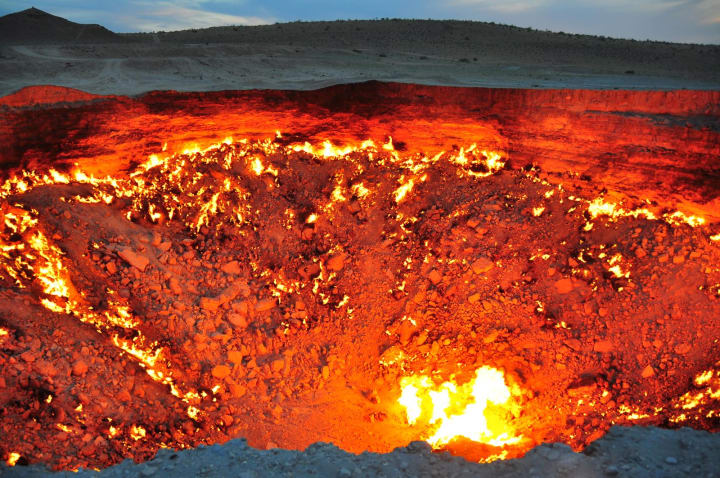
The Darvaza gas crater, also known as the "Door to Hell" or Turkmenistan's Gate of Hell, is one of the world's most fascinating natural wonders. The crater, located in the Karakum Desert in Turkmenistan, has been burning for over 50 years, continuously releasing gas and flames into the atmosphere.
The story of how the crater came to be is shrouded in mystery and intrigue. Many believe that it was created by a Soviet drilling accident in the 1970s, while others claim that it has been burning for centuries and has a supernatural origin.
According to one theory, the Darvaza gas crater was created when a Soviet drilling team accidentally tapped into a vast underground gas reservoir in 1971. As the drilling rig collapsed into the ground, it created a massive hole that began to spew natural gas. Fearing that the gas would poison nearby villages, the team set the gas on fire, hoping that it would burn itself out within a few days.
However, the fire has been burning for over 50 years, attracting tourists and scientists from around the world. Some believe that the gas reserve beneath the crater is so vast that it will continue to burn for centuries to come.
Others, however, believe that the Darvaza gas crater has a more sinister origin. Legend has it that the crater was created by a group of local shepherds who angered a demon by accidentally killing one of its offspring. In revenge, the demon opened up the ground beneath their feet, creating the fiery crater that has been burning ever since.
Despite the mysterious origin of the Darvaza gas crater, scientists have found it to be an excellent location for studying extreme environments and the unique microbial life that thrives in them. The extreme heat and toxic gases make it almost impossible for most organisms to survive, but scientists have discovered a diverse community of bacteria and other microorganisms that have adapted to live in these harsh conditions.
The Darvaza gas crater continues to burn to this day, a testament to the mysteries of the natural world and the enduring fascination of humankind with the unknown.



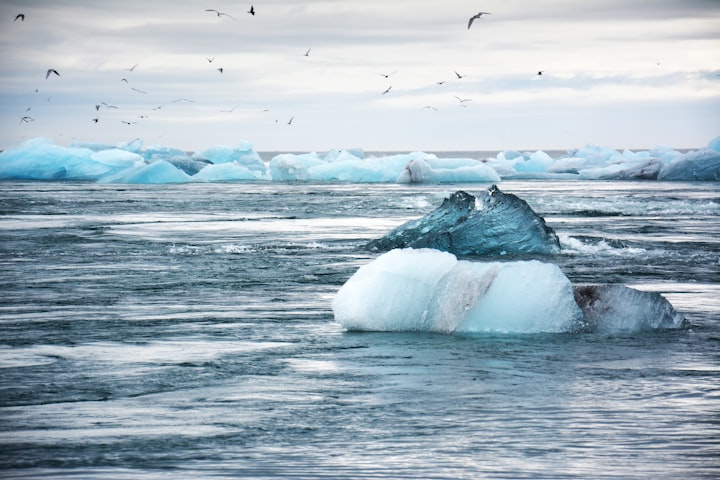


Comments
There are no comments for this story
Be the first to respond and start the conversation.